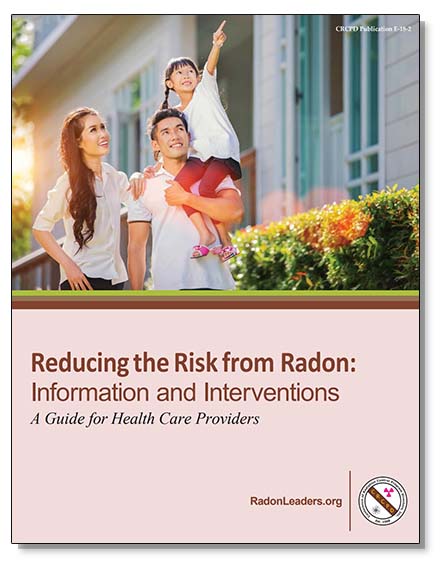Physicians & Healthcare Professionals
Radon Guidance for Physicians and Healthcare Professionals
Radon is a leading environmental cause of cancer mortality in the United States. According to EPA’s Assessment of Risks from Radon in Homes, radon alone causes 21,100 lung cancer deaths per year. Physicians and healthcare providers are primary advisors for health and disease prevention and therefore play a vital role in educating patients and reducing their exposure to radiation.
It is important to reduce lung cancer risk by explaining radon exposure to patients and encouraging radon testing in homes. CRCPD’s “Reducing the Risk from Radon: Information and Interventions, A Guide for Health Care Providers” offers guidance and intervention techniques for healthcare workers.
"A Physician’s Guide to Radon" was developed for physicians by the EPA in consultation with the American Medical Association (AMA). Its purpose is to enlist physicians in the national effort to inform the American public about the serious health risk posed by indoor radon gas.
Patient Guidance
The Agency for Toxic Substance and Diseases (ATSDR) provides patient instruction guidelines that aim to reduce health complications due to radon exposure. Physicians should advise patients to test their homes for radon to ensure safety. If testing results in a concentration of 4 pCi/L or above, the physician should recommend that patients take action to reduce radon levels in their home.
Healthcare providers should talk with their patients about exposure risks and potential uptake of toxic substances. Additional counseling should be provided for those who smoke as this increases the likelihood of developing lung cancer from radon.
The Combination of Radon and Tobacco Exposure
In particular, health effects from radon exposure and tobacco use are synergistic.
This chart from CRCPD’s radon reduction guide for healthcare providersshows the comparative risk of smokers' and non-smokers' development of lung cancer from radon exposure.

Preventative measures can allow patients to avoid radon exposure and potential risk of lung cancer. ATSDR provides a Patient Education and Care Instruction Sheet for Radon Toxicity. The American Medical Association (AMA) provides recommendations for screening for lung cancer.
Quick Links for Physicians and Healthcare Professionals
- Reducing the Risk from Radon: Information and Interventions, A Guide for Health Care Providers
- What Instructions Should Be Given to Patients to Reduce Potential Health Risks from Exposure to Radon?, ATSDR
- 20% of Lung Cancer Deaths Are Preventable: Here’s What You Can Do, American Lung Association
- EPA Assessment of Risks from Radon in Homes
Radon
-
Address
911 Boston Ave | Box 41023 | Lubbock, TX 79409-1023 -
Phone
806.834.0370 -
Email
kayleigh.millerick@ttu.edu

